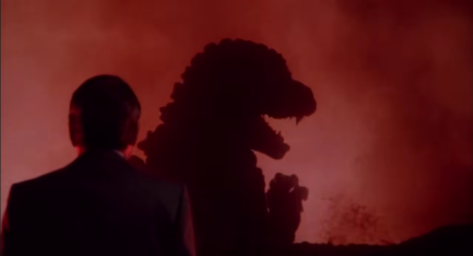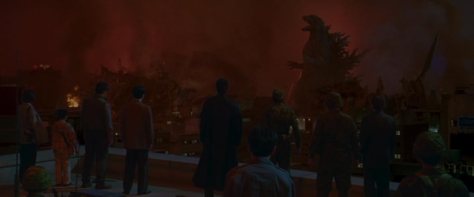
Godzilla Vs. Biollante (1989)
The first Vs. movie of the Heisei era is kind of odd and patchy – the actual confrontations between the titular monsters are few, far between, and fairly short, with the rest of the action devoted to more military hardware nonsense. Though brief, the fights manage to be enjoyably grotesque (as is the general relationship between the two monsters – Godzilla confronted by his mutant female clone), mainly because of how well-realized Biollante’s two forms are – it is a visually and conceptually unique creation (although its characteristics are weirdly muddled at times – especially by the ending.) It’s kind of a shame that the crew shied away from making more new monsters afterwards.
It is neat how the film, right from the hop, establishes a reality where the aftermath of Godzilla’s appearance has consequences – in this case, the harvesting of his cells and the political and corporate espionage games that make up the human part of the plot (except for the introduction of the psychics, which is important for the entire Heisei series, but man is it also really weird.) The presence of a giant radioactive monster leads to a whole load of other things, not the least of which is another monster engineered from his DNA – it gives the whole streak of movies a through-line, even if its not always capitalized on fully. The monsters’ existence having that kind of weight is definitely an interesting way to get the franchise rolling again.

Godzilla Vs. Mothra (1992)
This is an ostensible remake of both Mothra and Mothra Vs. Godzilla happening at the same time, and Godzilla often feels like a third wheel, simply sauntering onscreen to sock whatever giant bug is closest at the time. But while his bearing on the plot is more or less minimal, it sort of makes sense to have him there – with Mothra and Battra as the spirits of the natural world (who, naturally, have clashing ideologies regarding the human race), just about the only thing that could bring them together in the end is a monstrous reminder of how humanity alters nature. Godzilla, then, becomes the mechanic in which the two counterparts reconcile – it’s not smooth, but it is enjoyable. The reconciliation is also paralleled in the human scenes as well, with the separated couple coming back together for the benefit of others – just like the giant flying insects!
While the environmental subplot is mostly in the background, the movie does wring out at least one good scene with it, where the amoral CEO says something along the lines of “I don’t care if they destroy the city, I’ll just rebuild it!” This is the whole “technological solution for a technological problem” (that is later repeated in Destoroyah) in a nutshell – having the money and the means allows some to ignore the problems they cause. It’s brief, but its a reminder of what is being confronted every time one of these movies are made.

Godzilla Against Mechagodzilla (2002)
It’s a real shame that the most interesting idea in the movie – that the “DNA computer” made from Godzilla 54’s remains gives Mechagodzilla the creature’s memories – is dropped in the second half, because this otherwise solid action-heavy entry could have been even more worthwhile if they explored it more. I mean, after the really cool scene where the robot goes berserk until it runs out of power, they only bring it up again by having Mecha-G’s pilot make vague statements about “feeling” what it wants (and trying to parallel herself with it) – that allows them to give lip service to their concept even though they had no idea how to really follow it up. It’s an interesting take on Godzilla-counterpart theme so common in these later movies, but again, it only gets a small percentage of the movie here.
Godzilla continues his run as purely antagonistic in the Heisei through Millenium continuum in this as well, although in some ways he seems more like a walking natural disaster here – and so the focus on political fallout/governmental/bureaucratic response to a new Godzilla attack becomes a fairly interesting theme running in the background (the practicality of building a giant robot is at least brought up, which is always fun). At the same time, the pilot’s arc – overcoming her trauma, guilt, and fatalism – pushes Godzilla more in the villain direction, as something that must be defeated rather than just overcome. The plurality of perspectives makes the scenes without monster fighting a little more engaging, although its never as interesting as those aforementioned concepts they only toyed with.

Godzilla: Tokyo SOS (2003)
Almost more of a supplement to Against Mechagodzilla, Tokyo SOS allows them to go back to the Mechagodzilla-as-Godzilla’s-ghost and do a lot more with it. It takes the previous movie’s implied history of monster fighting and runs with it, creating a background legacy of kaiju attacks on Japan that gives the more threadbare human scenes an interesting twist. Once again, Mothra has to play both sides of the fence here, promising to protect Japan from Godzilla as long as they return Godzilla ’54’s remains to the sea – but why should they trust another monster with its own agenda? The conflict between the natural order and human designs (after all, the Godzillas were the results of humanity’s own actions, and the presence of one Godzilla seems to attract the presence of another, it seems – which is an idea picked up from Biollante) goes in its own very weird direction – it’s not enough that humans create these radioactive monstrosities, they can’t even let the dead rest in peace, which might be an even greater affront.
I thought it was interesting that primary human perspective shifted from the military-trained pilots to the actual mechanics – after all, who else would have the same kind of relationship with Mechagodzilla than the ones who actually build and maintain it? It makes the film’s universe feel a lot bigger – there are many people involved with the building of a robot monster to fight another monster, and we get to see even more of them here. In the finale, where Mechagodzilla takes matters into its own hands and piledrives Godzilla to the bottom of the sea, the connection between the mechanic and his beloved machine gives it an emotional hook (Godzilla-ghost-robot even manages to say goodbye!) It even raises some questions about the the robot’s actions – was it merely trying to defeat its enemy or return to its resting place, or was it atoning for its past destructive behaviour now that it has gotten to know its human victims better?







